Employee verbal warning letter template
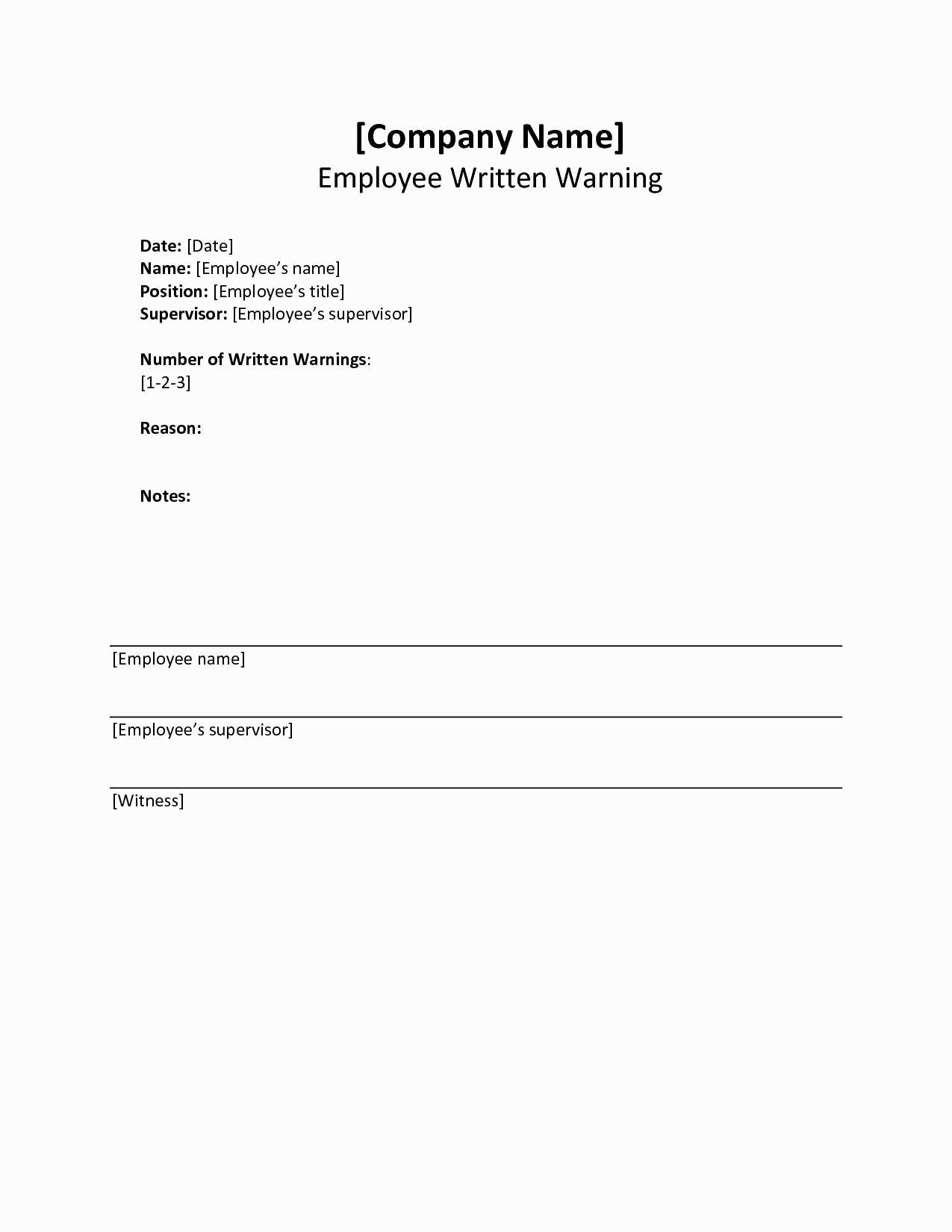
It is important to document all employee interactions related to performance issues, especially when it comes to formal warnings. A verbal warning is a first step in addressing behavioral or performance problems, and having a clear, structured approach can help avoid misunderstandings and potential legal complications. This letter template serves as a useful tool for addressing specific concerns with an employee while ensuring that the process remains fair and transparent.
When writing a verbal warning letter, be direct about the issue at hand. Clearly outline the behavior or performance problem, citing specific examples. Describe how this impacts the team or company to help the employee understand the context of the warning. Avoid vague statements; instead, focus on factual information that supports your reasoning for the warning.
Keep the tone professional but respectful. The goal is to provide constructive feedback while maintaining a positive working relationship. Let the employee know that this is an opportunity for improvement, and offer guidance on how they can correct the behavior or meet performance expectations. Make it clear that future warnings may escalate to written warnings if improvements are not made.
Finally, ensure that both parties sign the letter to confirm the discussion took place. This formal acknowledgment protects both the employee and employer by creating a record of the conversation. The letter should be kept in the employee’s file for future reference if necessary.
- Employee Verbal Warning Letter Template
Use the following template for issuing a verbal warning to an employee. Adjust the details to match your company’s policies and the specific situation. Be clear, direct, and respectful throughout the process.
Template
Employee Name: [Employee’s Full Name]
Position: [Employee’s Job Title]
Date: [Date of Verbal Warning]
Dear [Employee’s First Name],
This letter serves as a formal record of the verbal warning issued to you on [Date of Warning] regarding [the specific issue(s) that led to the warning]. During our conversation, we discussed the following points:
- [Describe the specific behavior or performance issue.]
- [Explain how the behavior is impacting the company, team, or workflow.]
We agreed that the following steps would help improve your performance moving forward:
- [State the action(s) the employee should take to improve.]
- [Mention any deadlines, support, or training to assist the employee.]
This verbal warning is intended to provide clarity and encourage improvement. If the issue persists or if there is no significant improvement, further disciplinary actions may be considered. Please take this warning seriously and make the necessary changes to meet company expectations.
Thank you for your attention to this matter. If you have any questions or need clarification, feel free to reach out.
Sincerely,
[Your Name]
[Your Job Title]
[Company Name]
Begin with a clear header, including the date and the employee’s name, to establish the context. Address the employee in a professional yet approachable tone, specifying the reason for the meeting and the behavior that triggered the warning. It’s important to describe the incident factually, avoiding any emotional language or assumptions.
1. Outline the Issue
Clearly identify the action or behavior that led to the verbal warning. Include specific examples to ensure there is no ambiguity. For example, mention missed deadlines, improper conduct, or failure to follow company policies. Referencing the employee’s previous discussions about the issue helps highlight the ongoing nature of the problem.
2. Explain the Impact
Describe how the behavior affects the team, department, or company. This helps the employee understand the larger consequences of their actions. Keep this section concise but precise, linking the behavior to its impact on productivity, morale, or company reputation.
3. State Expectations Going Forward
Set clear expectations for future behavior. Specify what the employee must do differently to avoid further action. This section should focus on positive changes and encourage the employee to improve.
4. Offer Support
Let the employee know that the company is willing to support them in making necessary changes. Mention any available resources, such as training or guidance, that can help them meet expectations.
Conclude by inviting the employee to respond or ask questions. Make sure to offer a path for future communication and improvement.
In an employee verbal warning letter, the following details are necessary to clearly address the issue at hand:
1. Employee Details
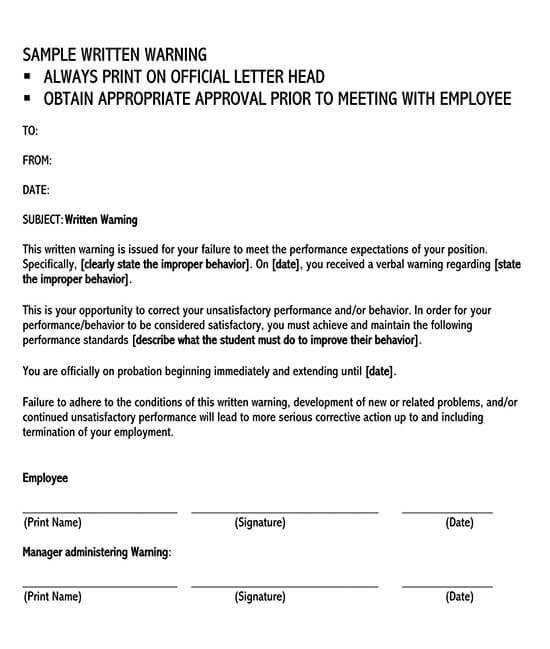
Begin with the employee’s full name, job title, and department. This helps in properly identifying the individual involved and ensures clarity in any future references to this matter.
2. Date and Incident Description
Specify the date of the warning and the exact incident or behavior that triggered the warning. Provide clear and concise details about the issue, including any facts or evidence that highlight the employee’s performance or conduct problems.
3. Explanation of Policy Violation
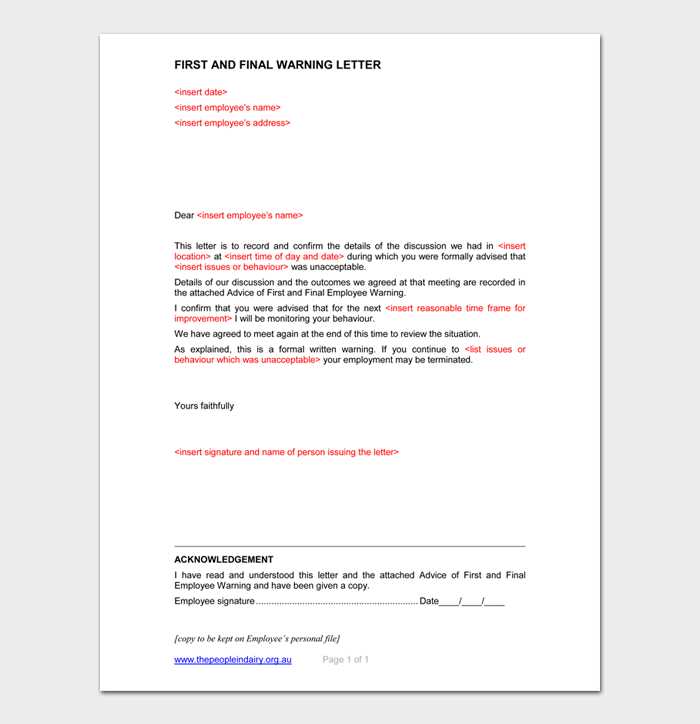
Describe the company policy or procedure that was violated. Reference specific rules or guidelines from the employee handbook or work agreements. Be direct and factual in stating how the employee’s actions deviate from expected standards.
4. Impact of the Violation
Clarify the consequences of the behavior on the team or company, such as reduced productivity or potential harm to the organization’s reputation. This section explains the severity of the issue and why corrective action is necessary.
5. Expectations for Improvement
Outline the steps the employee needs to take to rectify the situation. Be clear about the behavior or performance changes expected, as well as any support or resources the company may provide to help the employee succeed.
6. Possible Consequences of Further Violations
Explain the next steps if the employee fails to improve. Mention the possibility of further disciplinary action, including suspension or termination. This helps set clear boundaries for the employee moving forward.
7. Acknowledgement of Receipt
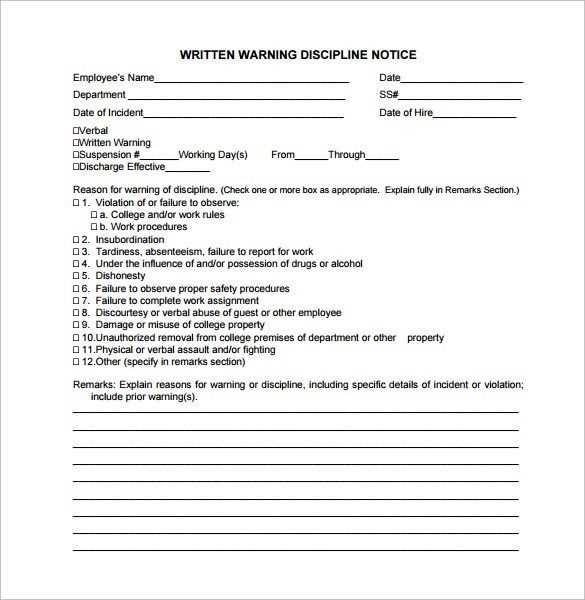
Include a statement asking the employee to acknowledge receipt of the warning letter. This can be done through a signature, indicating they have read and understood the content of the letter.
8. Signature and Date
Conclude with the signatures of the person issuing the warning and the employee. The date the warning is issued should also be noted to ensure proper documentation.
| Key Information | Details |
|---|---|
| Employee Name | John Doe |
| Incident Date | January 15, 2025 |
| Violation Description | Failure to meet sales targets |
| Policy Violated | Sales Performance Policy |
| Expected Improvement | Increase sales by 15% in the next quarter |
| Consequence of Further Violations | Potential suspension |
| Signature | _____________________ |
Ensure that the verbal warning is documented. Record the details, such as the date, the reason for the warning, and any actions agreed upon. This protects both the employer and the employee in case of future disputes.
Adherence to Company Policies
Review your company’s policies before issuing any warning. The verbal warning should align with internal disciplinary procedures. If a formal process exists, make sure to follow it step by step to maintain fairness and consistency.
Consistency and Fairness
Consistent treatment of all employees is critical. A verbal warning should not appear discriminatory or unfair. Avoid giving warnings based on personal biases or selective enforcement.
Confidentiality
Discuss the warning in private to protect the employee’s dignity. Sharing the details with others may result in privacy violations and legal claims.
Employee’s Right to Respond
Allow the employee to explain their side. Giving them a chance to respond to the warning ensures that they feel heard and treated with respect, which may help avoid any claims of unfair treatment.
Legal Risks
Be cautious when issuing verbal warnings. In some cases, they may escalate into formal disciplinary actions or even legal claims if not handled correctly. Always ensure compliance with employment laws in your jurisdiction to avoid potential legal risks.
Documenting the Warning
Although verbal, a warning should still be documented. It serves as a record in case of further disciplinary action. Have both the employee and a supervisor sign the documentation to confirm mutual understanding of the discussion.
Table of Legal Considerations
| Consideration | Action |
|---|---|
| Consistency | Apply company policies fairly to all employees |
| Confidentiality | Ensure the warning is discussed in private |
| Documentation | Record details of the verbal warning for future reference |
| Employee Response | Allow the employee to provide their side of the story |
| Legal Compliance | Follow legal and company procedures to avoid claims |
Ensure that the warning letter is clear, concise, and objective. Avoid vague language or generalizations that can lead to misunderstandings. Be specific about the issue that prompted the warning.
1. Lack of Specificity
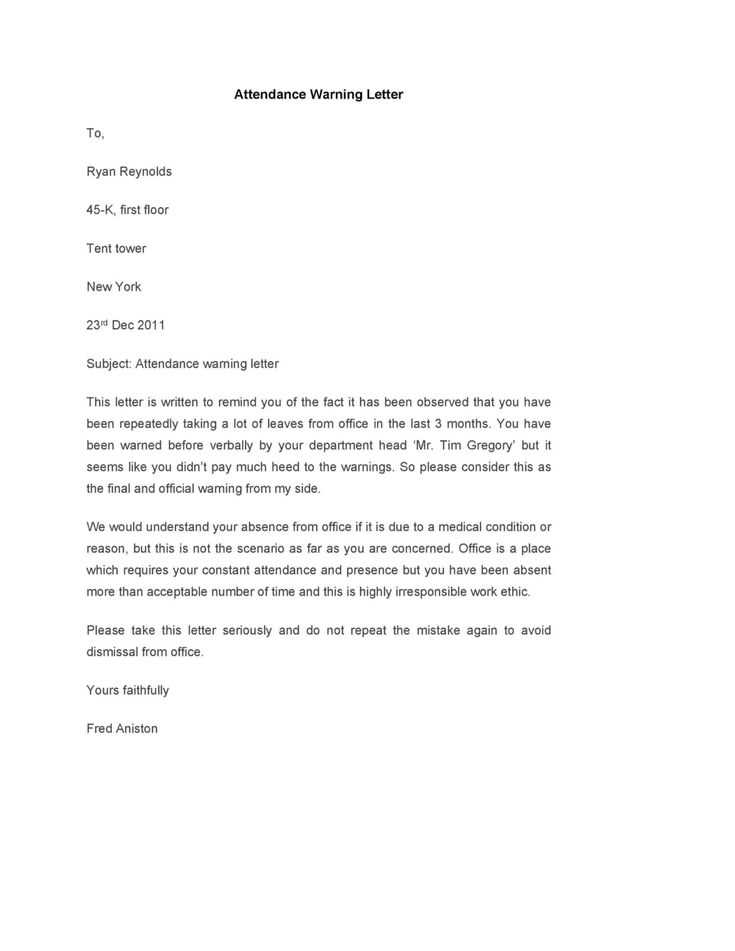
Don’t use broad statements like “improvement needed” or “unsatisfactory performance.” Detail the exact behavior or performance that requires attention. For example, instead of saying “you were late,” specify “you were late for three shifts in the past week, arriving at 9:15 AM instead of the scheduled 9:00 AM.”
2. Using Ambiguous or Passive Language
Passive language can make the situation unclear. Instead of saying “It seems there were some issues with your work,” state “Your recent reports contained multiple errors that delayed the project.” Using clear and direct language ensures the employee understands the issue.
3. Failing to Document Previous Warnings
It’s important to mention any previous discussions or warnings. If this is the first formal warning, make sure to note that it is a formal step. If there were prior informal discussions, reference them to show that this is not the first time the issue has been raised.
4. Not Offering a Solution
Merely pointing out the problem without offering a clear course of action is unhelpful. Include specific steps the employee needs to take to improve. For example, “Please ensure you arrive at work on time and inform your supervisor if you anticipate being late.” This helps the employee understand expectations and how to correct the issue.
5. Being Too Harsh or Emotional
While the letter should address serious concerns, avoid a tone that is overly critical or emotional. The goal is to encourage improvement, not to demoralize the employee. Keep the language professional and objective.
6. Neglecting to Include a Follow-Up
Always include a plan for follow-up. For example, “We will meet in two weeks to review your progress.” This demonstrates your commitment to supporting the employee’s development and provides them with an opportunity to improve.
7. Ignoring Company Policies
Ensure that the warning letter aligns with your company’s policies and procedures. Disregarding these guidelines can undermine the process and potentially open the company to legal issues.
Set a private, quiet environment to ensure confidentiality. A calm space prevents distractions and helps the conversation stay focused.
Be direct and clear when addressing the issue. Explain the specific behavior or action that prompted the warning, using examples to provide context.
Avoid making the conversation feel personal or accusatory. Focus on the actions and how they impact the workplace rather than making judgments about the individual.
Ensure the employee understands the expected behavior moving forward. Be specific about the changes needed and explain any consequences for continued issues.
Maintain a calm and neutral tone throughout the conversation. Emotional reactions can derail the discussion and may make the employee feel defensive.
Offer the employee a chance to explain their side. Active listening shows respect and helps address potential misunderstandings or mitigating factors.
Document the warning for future reference. Keep a record of what was discussed, along with any follow-up actions, to ensure clarity and avoid miscommunication later on.
End the discussion on a constructive note, reinforcing support and your willingness to help the employee improve. This shows you’re committed to their success.
Accurately documenting and tracking employee warnings prevents confusion and protects the organization from potential legal issues. Create a standardized process for recording each warning that includes key details: date, employee name, nature of the issue, actions taken, and follow-up steps. Maintain a clear timeline of all warnings, noting when previous issues were addressed and how the employee responded. This helps identify patterns or recurring issues that need attention.
Use a Consistent Format
Establish a template for all warning letters to ensure consistency. Include sections such as a description of the behavior or performance issue, a reminder of company policies, the expected improvement, and consequences if there is no change. This format should be followed for every warning, regardless of the severity of the incident, to maintain fairness and clarity.
Keep Records Secure and Accessible
Store warning letters in a secure but accessible system, whether digital or physical. Ensure that only authorized personnel can view these documents, while allowing managers to easily track a history of warnings. Regularly review this documentation to ensure it is accurate and up-to-date, providing a reliable resource for any future personnel decisions.
Verbal Warning Letter Template
Use the following steps to craft an effective verbal warning letter:
- Begin with a clear statement of the issue. Address the specific behavior or performance problem that prompted the warning.
- Detail the impact of the issue. Explain how the behavior or performance is affecting the team, the company, or individual performance.
- Reference any previous discussions or warnings. If applicable, mention prior informal or formal communications about the issue.
- Outline the expectations moving forward. Clearly define what needs to improve and what acceptable behavior or performance looks like.
- Provide a timeline for improvement. Specify a reasonable time frame in which the employee must show progress or resolve the issue.
- Offer assistance if needed. If appropriate, mention any resources, support, or guidance available to help the employee improve.
- End with a reminder of the consequences. State the potential consequences if the behavior does not improve, such as further disciplinary action.